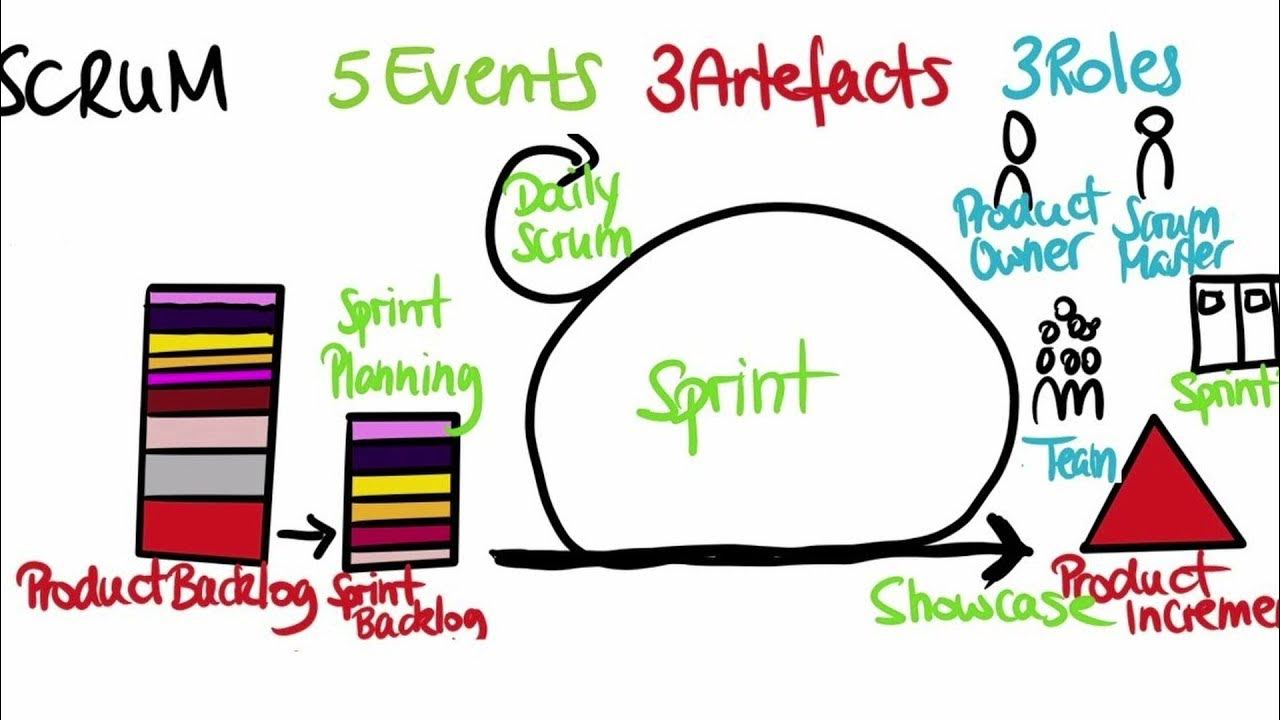Scrum Essentials in Under 10 Minutes
Summary
TLDRStuart, a Scrum Alliance member, introduces Scrum as a framework for creating value through adaptive solutions to complex problems. It emphasizes lean thinking and empiricism, with three supporting pillars: transparency, inspection, and adaptation. The Scrum team, consisting of a Scrum Master, Product Owner, and Developers, works in Sprints to deliver usable increments. Key artifacts include the Product Backlog, Sprint Backlog, and Increment. The process involves Sprint Planning, Daily Scrums, Sprint Reviews, and Retrospectives, aiming to maximize value and adapt based on learnings. The five Scrum values—commitment, focus, openness, respect, and courage—are crucial for success.
Takeaways
- 📚 Scrum is a framework that facilitates teams to deliver value through adaptive solutions for complex problems.
- 🏗️ The foundation of Scrum is based on lean thinking and empiricism, which focuses on reducing waste and making decisions based on observed experiences.
- 🌐 Scrum's three pillars are transparency, inspection, and adaptation, which support the creation of value through visibility and continuous improvement.
- 👥 A Scrum team is self-managing and cross-functional, consisting of a Scrum Master, a Product Owner, and Developers who are committed to creating usable increments.
- 🛠️ The Product Owner is responsible for maximizing the product's value and managing the product backlog, which is a list of improvements needed for the product.
- 👨🏫 The Scrum Master ensures the team's effectiveness by establishing Scrum practices and helping everyone understand Scrum theory and practice.
- 🔄 The Sprint is a fixed-length event where the team turns ideas into value through a series of planned and adaptive events, including planning, daily scrums, reviews, and retrospectives.
- 📈 The product backlog is an ordered list of work needed to improve the product, and it serves as the source of work for the Scrum team.
- 🔍 The Sprint backlog is a real-time view of the work the developers plan to accomplish during the Sprint, which is highly visible and adaptable.
- 🚀 The increment is the output of the Sprint, which is a usable and verified product that adds value and is fully integrated with prior increments.
- 🔄 Sprint planning involves discussing the value of the Sprint, selecting work from the product backlog, and planning how to achieve the Sprint goal within the Sprint backlog.
Q & A
What is Scrum and what does it help with?
-Scrum is a lightweight framework that helps people, teams, and organizations generate value through adaptive solutions for complex problems. It is used to create products as a vehicle to deliver value.
What is the foundation of Scrum?
-The foundation of Scrum is lean thinking and empiricism. Lean thinking focuses on reducing waste, while empiricism asserts that knowledge comes from experience and making decisions based on what is observed.
What are the three pillars that support empiricism in Scrum?
-The three pillars that support empiricism in Scrum are transparency, inspection, and adaptation. Transparency makes work and process visible, inspection enables the detection of variances or problems, and adaptation is provoked by Scrum to improve the product and processes.
What is the role of a Scrum team in Scrum?
-A Scrum team is a small, self-managing, cross-functional group responsible for all product-related activities. It consists of a Scrum Master, a Product Owner, and Developers.
What are the responsibilities of the Scrum Master?
-The Scrum Master is accountable for the Scrum team's effectiveness by ensuring Scrum is established as defined in the Scrum guide. They help everyone understand Scrum theory and practice.
What is the role of the Product Owner in a Scrum team?
-The Product Owner is accountable for maximizing the value of the product resulting from the work of the Scrum team and manages the product backlog.
What are the key artifacts used by the Scrum team?
-The key artifacts used by the Scrum team are the product backlog, the Sprint backlog, and the increment. These artifacts represent work or value and are designed to maximize transparency.
What is the purpose of a Sprint in Scrum?
-A Sprint is a fixed-length event of one month or less where the Scrum team turns ideas into value through a series of formal inspect and adapt events, including Sprint planning, the daily Scrum, the Sprint review, and the Sprint retrospective.
What are the topics discussed during Sprint planning?
-During Sprint planning, the topics discussed include why the Sprint is valuable, what can be done in the Sprint, and how the chosen work will get done to meet the Sprint goal.
What is the purpose of the daily Scrum?
-The daily Scrum is a 15-minute event for the developers to inspect progress towards the Sprint goal and adapt the Sprint backlog as necessary.
What happens during a Sprint review?
-During a Sprint review, the Scrum team presents the results of their work to key stakeholders, discusses progress toward the product goal, and collaborates on what to do next.
What is the goal of a Sprint retrospective?
-The goal of a Sprint retrospective is to plan ways to increase quality and effectiveness by inspecting how the last Sprint went and identifying improvements to enhance the Scrum team's effectiveness.
What is product backlog refinement and when does it occur?
-Product backlog refinement is the act of breaking down and further defining product backlog items into smaller, more precise items. It occurs throughout the Sprint.
How do the Scrum values contribute to the success of Scrum?
-The Scrum values of commitment, focus, openness, respect, and courage, when embodied by the Scrum team and those they work with, bring the empirical Scrum pillars of transparency, inspection, and adaptation to life, building trust.
Outlines

此内容仅限付费用户访问。 请升级后访问。
立即升级Mindmap

此内容仅限付费用户访问。 请升级后访问。
立即升级Keywords

此内容仅限付费用户访问。 请升级后访问。
立即升级Highlights

此内容仅限付费用户访问。 请升级后访问。
立即升级Transcripts

此内容仅限付费用户访问。 请升级后访问。
立即升级5.0 / 5 (0 votes)






